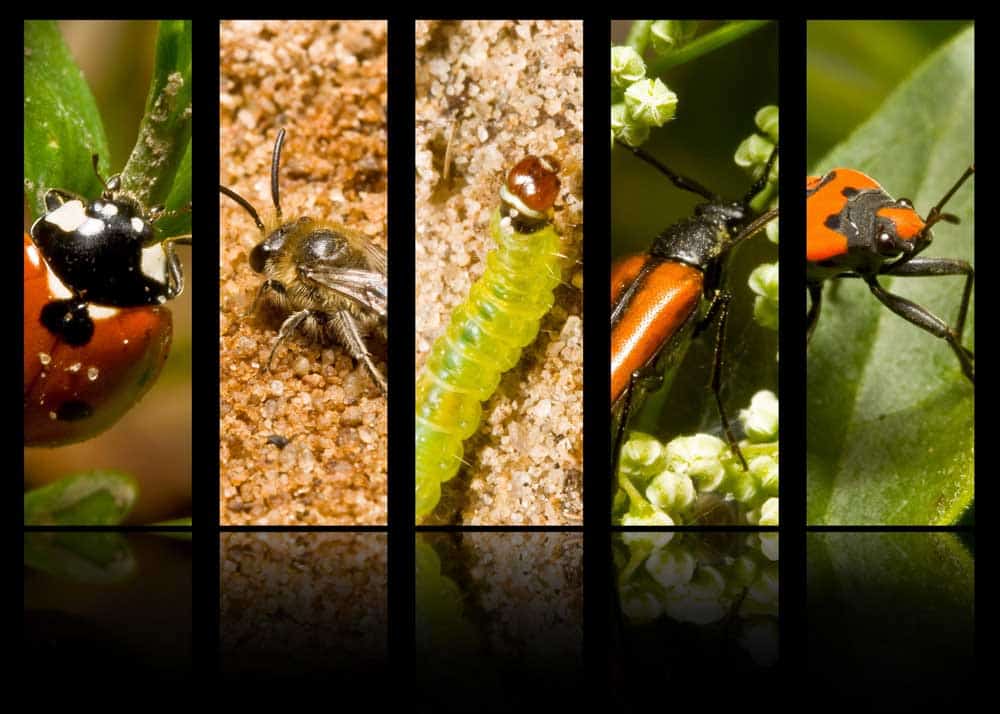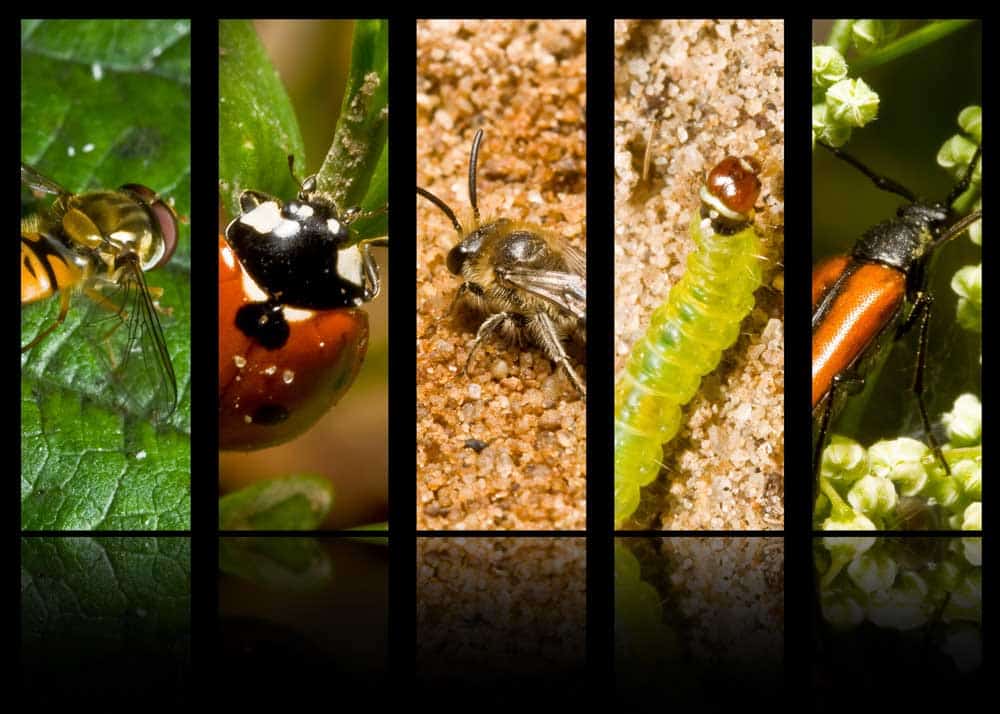If you thought bugs and insects were the same things, you’re not alone. A lot of people use the two words interchangeably, but they don’t have the same meaning. You may even hear a scientist using the word bug as a generic term for an insect. However, in a technical sense, the two words have different meanings.
Are bugs and insects the same? It’s not simply a matter of bug being a more cutesy or common way to say insect. The truth is that not all insects are bugs, but all bugs are insects. Insects represent a larger group into which bugs fall. Bugs are actually a specific order within the insect class of animals.

To fully understand the differences between bugs and insects, we need to understand what an insect is. Then, we can dive deeper into learning about the insect order that contains bugs to find their key differences.
Table of Contents
What is an Insect?
In the eighteenth century, Carl Linnaeus created a way to divide organisms into a hierarchical taxonomy, with every organism dividing into smaller and smaller groups with features in common.
The biggest of these groups is the domain, with the smallest group being an organism’s species.
An insect is in a higher taxonomic class than a bug:
- Eukarya Domain: Insects belong to a large category of eukaryotic organisms whose cells have a nucleus and organelles.
- Animalia Kingdom: Insects are in the Animalia kingdom, which is the kingdom that humans belong to, too.
- Arthropod Phylum: Arthropods do not have a backbone and include animals, such as insects, spiders, and crustaceans.
- Insecta Class: Insects are part of the Insecta class–the largest group of Arthropods.
5 Insect Features
When we look at an insect, we can see that it has several specific characteristics:
- A hard, chitinous exoskeleton
- A body with three parts (head, thorax, and abdomen)
- Three pairs of jointed legs (for a total of six legs)
- Compound eyes
- Antennae
Some insects you might recognize include ants, wasps, cockroaches, camel crickets, fireflies, jiggers, and stink bugs.
Learn more about 6-legged insects.
What Is a Bug?
Are bugs and insects the same? Within the Insecta class, there are 24 insect orders into which we can further divide insects. One of these orders is Hemiptera, which are what we call bugs.
Bugs are a subset of insects.
It is in a lower taxonomic class than an insect:
- Eukarya Domain: Bugs are in the same domain as insects.
- Animalia Kingdom: Bugs are in the same kingdom as insects
- Arthropod Phylum: Bugs are in the same phylum as insects.
- Insecta Class: Bugs are in the Insecta class with insects.
- Hemiptera Order: Bugs are in the Hemiptera order
You can break bugs further down into:
- Four orders (Auchenorrhyncha, Coleorrhyncha, Heteroptera, and Sternorrhyncha)
- Families within each order
- Genus within each family
- Species within each genus
6 Bug (Hemiptera) Features
Hemiptera is called true bugs. There are more than 80,00 species of Hemiptera.
Each one of these 80,000 bugs has features that set them apart from other types of insects:
- Four wings folded flat over their body
- Scutellum (a visible triangle at the center of their back that the wings don’t cover)
- Two front wings have a thick and leathery base with translucent membranous tips or ends
- Long, segmented antennae
- A beak arising from the front of the head
- Straw-shaped piercing and sucking mouthparts (stylets) for sucking sap or blood
Immature bugs look similar to adults but without wings.
Most are less than half an inch long, except for some aquatic ones over two inches long.
Types of Bugs
Here are some true bugs with which you might be familiar:
- Water striders
- Assassin bug
- Wheel bug
- Stink bug
- Bed bug
However, confusingly, not every insect with the word bug as a part of its name is a true bug in the Hemiptera order.
For example, ladybugs and June bugs are more properly called lady beetles and June beetles, falling in the Coleoptera family. So, if you thought beetles were bugs, you had it wrong.
Don’t worry; even some scientists tend to use the words bugs and insects interchangeably and call lady beetles and June bugs by their more common names instead.

Learn more about other small black, biting bugs.
3 Key Differences Between Insects and Bugs
Let’s explore the three differences between bugs and insects a little more deeply, looking at their relationship to insects, their wings, and their mouths.
Are bugs and insects the same?
Here’s what sets them apart:
1. Bugs Are an Order Within the Insecta Class
There are around 900,000 known types of insects in the world. Within the Insecta class, only 80,000 are bugs (Hemiptera).
2. Bugs Have Distinctive Wings
Not all insects have wings. And some insects have underdeveloped wings.
However, when insects do have wings, they tend to come in two pairs, for a total of four wings.
All true bugs have four wings. However, the way bug wings differ from the wings of other insects is where true bugs get the name Hemiptera.
The bases of the bugs’ two front wings are thick and leathery. Meanwhile, the tips or ends are membranous. This type of wing is called hemelytron.
Meanwhile, bugs’ hind wings are shorter than their front wings and are completely membranous.
When true bugs hold their wings at rest, the wings rest over their abdomen, and the membranous tips overlap, revealing a small triangular plate on their backs called the scutellum. Scutellum also appears triangular in some beetles.
3. Bugs Have Piercing and Sucking Mouthparts
Hemipterans have a distinctive beak-like mouth at the front of their head with a stylet that can pierce and suck liquids through like a straw.
Many bugs use their stylet to suck plant sap. However, some bugs are predators that use their mouths to feed on insects, small invertebrates, or blood instead.
Some that plague humans include bed bugs and kissing bugs, which transmit Chagas disease.
Some insects have mouthparts that are confused with that of bugs. However, they have biting mandibles and maxillae instead of stylets. The only other insects that have anything similar to bug mouthparts are some Phthiraptera (lice). However, the overall structure is different.
What about spiders? Do only spiders have 8 legs?
Final Thoughts on Bugs and Insects
Are bugs and insects the same? Bugs are a type of insect that have distinctive characteristics that set them apart from other insects. The main things that set them apart are their wing structure and appearance and their distinctive mouthparts.
Don’t worry, though. If you accidentally call a non-bug a bug, not too many people will get upset. However, knowing the characteristics that set bugs apart from other insects can help identify insect types.
- About the Author
- Latest Posts
Bryan Haines is a co-founder and writer at The Buginator. And is working to make it the best resource for taking back the outdoors from biting, stinging pests.
He also blogs about travel at Storyteller.Travel and photography at Storyteller Tech. Bryan is a partner at Storyteller Media, a publishing company he runs with his wife, Dena.
